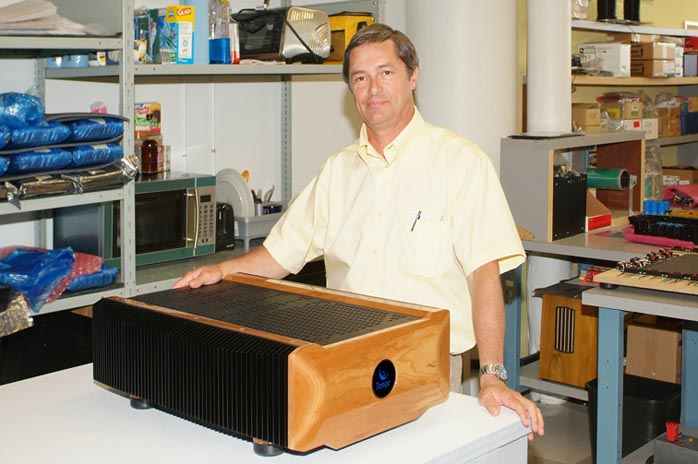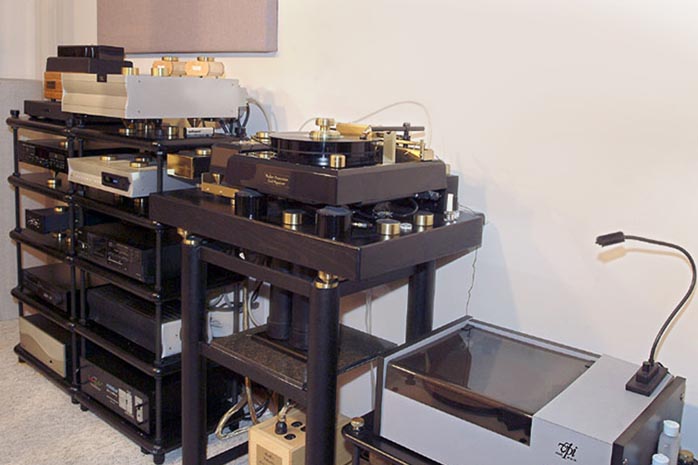|
|
|
|
|
This review page is supported in part by the sponsor whose ad is displayed above
|
|
 |
|
Tenor mounts the MOSFETs on thermal pads which change physical properties with temperature. Below 50°C, the material is a solid; when the temperature exceeds 50°, the material liquefies somewhat, increasing the quality of the contact between transistor and heat sink. It in effect compensates for small manufacturing variations in the heat sink and increases thermal conduction.
This is very important for a MOSFET where the first failure mode is over-temperature. A MOSFET is generally robust but it doesn't like to see high temperatures. As temperature increases, it ultimately overloads the transistor. That is why the heat sinks on the 350M are so big and why the presence of special thermal pads. While pumping through a 100-watt pure sine wave with no internal fans (the equivalent of more than 300 watts of real music), the heat sink measures only 42°C (approx 107F). When many amps would go into protection, the 350M can run almost indefinitely and at full power.
Minutiae alert - here comes the washer discussion from François: "When the device is tightened, we use a special tool and a custom cupped washer to precisely adjust the pressure against the heat sink. Everything is calibrated including the beveled washer. The screws are designed to work to specification and the beveled washer maintains a constant pressure of the transistor in contact with the heat sink. Specifically, the washers are calibrated so that when the cupping curvature is flattened, the washer itself will exert a known and fixed tension on the MOSFET. For example, a fully compressed washer might exert a pressure of 5psi. In actual construction, the washers are never fully flattened but adjusted for a specific working tension. If you screw directly onto the aluminum, the MOSFETs and the heat sink could expand at different rates and cause stress over a period of time. With our washer, you will maintain constant pressure and contact - forever."
Not enough detail? One more small taste of the Tenor design philosophy: "Even our screw costs three times the amount of the standard screw. The head is perfect, threads are finer quality, the finishing is better and we quality-control every single one. A typical screw has a slight roundness to the head and is not perfectly flat, which in this case would cause imperfect contact. Our screws are perfectly flat. The screw was designed to mate perfectly with the beveled washer. We experimented with six different washer and screw shapes before deciding on the current ones. A fortune in time and labor..."
Do you get the point? If you're this compulsive about a screw and a washer, how do you think they handle the big things? The answer is, of course, with the exact same driving passion. Moving back to the macro, the point is that this amp is designed to be a lifetime purchase. Yes, Tenor spent a small fortune designing and selecting the washers and screws but if the MOSFETs are reliable both physically and sonically ten years from now, isn't that part of what you are paying for? Impressed? Well, as the saying goes, you ain't seen nuttin' yet.
Let's head a little deeper into the forest. While it's great to purchase and assemble top quality components, any company with the appropriate financing and diligence can do it. Certainly more than a few hybrid amps have been marketed by competitors so what is it that catapults the 350Ms to the top of the pile? Again, it's back to the MOSFETs. François attributes part of the remarkable Tenor sound to the near instantaneous bias control system.
|
|
 |
|
|
|
François with his master piece
"Controlling the output MOSFET bias is the real trick. You cannot go too fast or too slow. Of course, first you must heat the transistor to its proper operating temperature, prevent it from overheating and keep it in the proper operating range. This is an extraordinarily delicate thing to balance."
The bias is continually adjusted by a proprietary temperature-monitoring system using Michel's theoretical calculations plus the known behavior of the transistor, the behavior of the reaction circuitry and the physical behavior of the heat combined with experimental data. This proprietary sensor system is far more than a heat sink sensor. Although many companies will measure temperature on the heat sink, it's crude and produces compensation lag. The reason for this is that just after a peak, your system would be biased beyond class B, which is not good for the sound because you get crossover distortions and other problems. Even if a sensor is bonded to the output device, François believes the results to be poor because the MOSFET case itself is a bad conductor. Tenor's proprietary bias sensing system is so sensitive that by merely blowing across the mounting plate of the MOSFETs, you can see and measure the change. The system reacts to a fraction of a degree of heat change, virtually instantaneously.
Competitors use a variety of systems to control bias from the simple to exotic. "Edge for example uses a fantastic system with lasers to control the bias. Everyone has the same problem because the transistor is not linear - you change the temperature and you change the gain. If you're able to perfectly control the behavior of the transistor over a wide range, then you end up with no dynamic compression."
Since all output MOSFETs are exactly matched, by measuring one device one is in reality measuring them all here. To increase accuracy, Michel has chosen to physically group the MOSFETs together on the heat sink in close proximity. "The transistors located in the same physical area will all get the same temperature; if separated, natural convection will make the ones at the top hotter and those on the bottom cooler. For the transistors this means that the bias necessary to output the required current will always vary - one transistor will draw less current than others because of the temperature difference. To avoid that problem, I aligned all the transistors in the same area of the heat sink. We use proprietary sensors to survey the P and N channel temperatures separately while another sensor measures the ambient temperature outside the heat sink. All of these together form an ultra-stable bias system. One of the characteristics to get good dynamic behavior with low distortion is to have the most stable bias possible."
There are two identical output stages working in parallel. Each stage receives an identical signal and works like a separate amplifier on the signal. They are not amplifying positive and negative signal phase. Each is a discrete amplifier with its own signal and biasing. Since the signal is essentially split between two output stages and then recombined to drive the speakers, I wondered if a failure on one side would cause a cascading imbalance damaging both sides? Surprisingly and counter-intuitively, no, you would simply lose power. Michel says that you could actually remove or disable one entire output side and the amp would continue to work, albeit at a lower power output and not into four ohms. Each of the parallel stages delivers 50% of the current to produce 175 watts output as though there were two amps in the monoblock. Their outputs sum to 350 watts total.
|
|
 |
|
|
"The inputs are parallel, the power supply is parallel and the output is parallel. To our knowledge, no one else does this as it is very tricky. If you have the slightest imbalance, the slightest phase difference, the slightest difference in gain, you will ultimately hurt the signal."
With this output configuration, you double the current and quadruple the dynamic current, permitting the amps to drive very low impedance. However, current sharing between the two output sides must be well controlled and the current must be perfectly shared between both 'halves' of the power stages.
Protection Circuitry
Everyone who has owned an OTL or is an experienced audiophile, has heard stories of OTL failures. Some true, some anecdotal, the reputation has dogged OTL design. In the past, these amps had what some call the 'Futterman Complex' - that unfortunate tendency to self destruct and take a speaker with them. Thankfully today those early side effects have long since been banished but because the old Tenor Audio Inc Company did suffer a few initial problems with their 300M hybrid, I wanted to understand the steps taken to provide reliability, output safety and protection.
Tenor states that the 350Ms are an entirely new product. However, when you're talking a component that can output over 1000 watts and costs a small fortune, it better damn well be bullet-proof and utterly reliable. What if the 350Ms are truly the best-sounding amplifiers on the planet yet suffer from OTLitis with a propensity to self-destruct or some other such maladies indigenous to an OTL design?
The bottom line is that these monsters better perform flawlessly because connected to megabucks speakers as they most likely will be, there must be 100% reliability with zero chance for any potential speaker damage. "We've spent two years and over $1 million just to improve what was already a very good amplifier [the original 300M]. The first target was to improve reliability on all counts. The first production pairs were actually so sensitive to RF signals and line variations that the protection circuitry would activate prematurely so we had to find the fine balance between absolute protection and usability."
Internally, these amps are designed like the proverbial tank. The cables connecting the output MOSFETs to the speaker terminals are rated at 95 amps continuous - equivalent to a four-gauge cable. A pure copper bus carries the output since there's no way for a circuit board trace to handle the current involved. The amplifier has essentially no limitation in current transfer. When current increases, voltage never drops below specifications. Tenor clams this current capacity to be a very important part of the dynamic range and linearity, especially at low impedance.
The 350M is designed with no current limiting from the power supply to the output. The only limit is a small resistor calibrated for 1,200 watts at 2 ohms. The resistor has no effect dynamically but if you reach that current at 2 ohms, the protection circuitry will kick in before the fuse blows. The fuses do not limit current but open only if there is a malfunction. During two years of testing, Tenor reports no output MOSFET failures.
If for any reason the temperature does rise above 75°C, protection circuits will temporarily shut down the amp. The front logo turns red and will reactivate when the temperature has dropped. If the temperature exceeds 80°C, protection circuits will turn the amplifier off. Actually, two separate thermal systems protect the unit.
Additional circuits protect against over-current, shorts, ground faults and excess RF to make things pretty much bullet-proof. Nothing in the protection circuitry mucks with the sound. There are no microprocessors, just a few logic gates and all are removed from the signal path. They just monitor the current. When a certain level is reached, it shuts down. A logic system measures and senses DC offset but again, never touches the signal path. Residual DC is virtually immeasurable.
In total, there are 11 fuses in the amplifier; six of them monitored by the logic system. I asked François if a power stage failure could induce a loud sickening transient from the speakers. He claims, "Absolutely not". They just go quickly into protection. In 1ms, the system is muted without relays because the output transistors themselves are shut down. The high voltage is monitored with the same system; therefore a tube short will produce nothing more than a muted output. |
|
|
 |
 |
|
|
 |
|
|
|
|
|
|
|